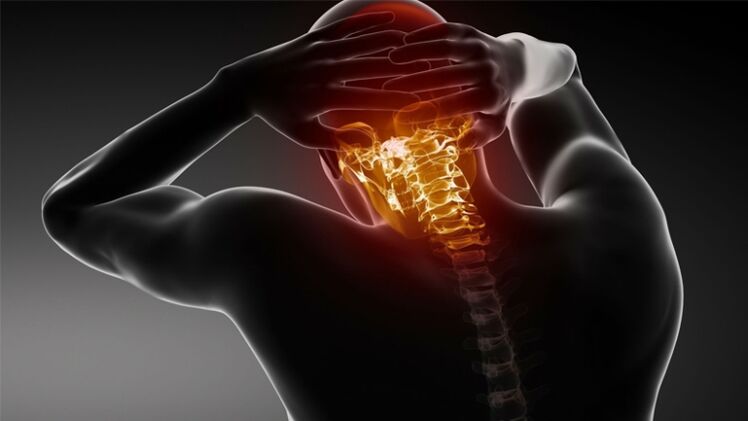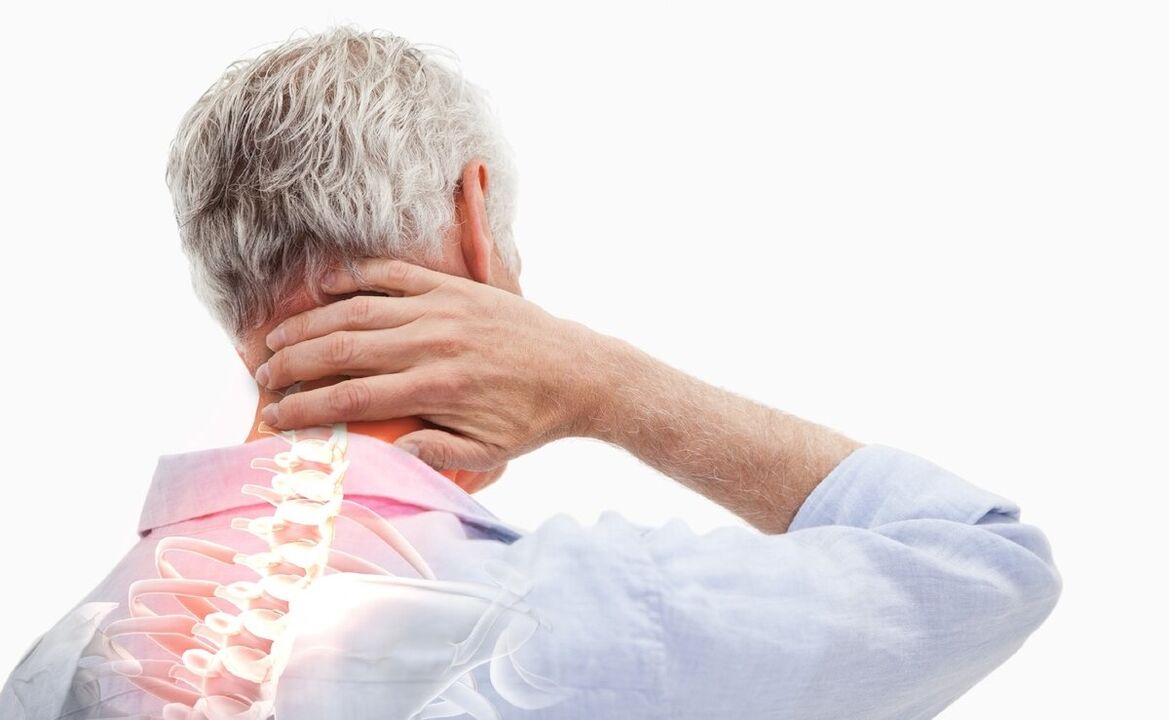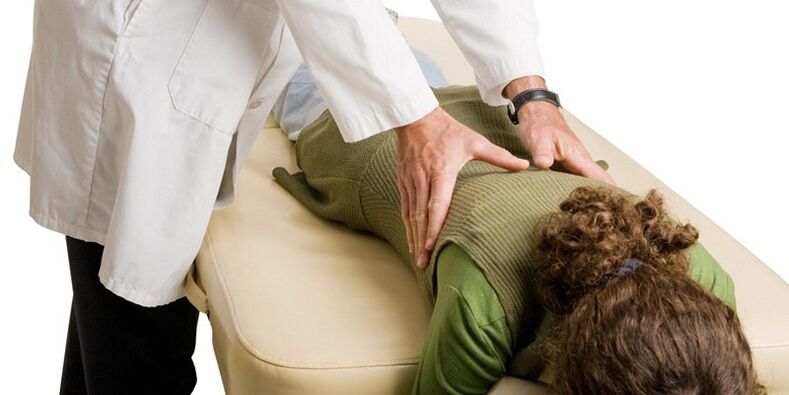
Osteochondrosis in medicine is usually called dystrophic changes of the intervertebral discs.This problem can appear in a person at absolutely any age.Dysfunction of the intervertebral discs can lead to the development of a number of unpleasant related health problems.Therefore, you should immediately pay attention to the signs of osteochondrosis of the cervical spine, and then start treatment immediately.
General description of the disease
The cervical spine contains 8 paired nerve bundles and 7 vertebrae.Osteochondrosis of the cervical spine is usually due to the fact that the intervertebral pulp degenerates into vitreous tissue.At the same time, pathological changes negatively affect the endings of nerve fibers and important blood vessels.This pathology mainly affects the 8th and 7th vertebrae.

Signs of cervical osteochondrosis are very easily confused with other pathologies.During the course of the disease, headache attacks can be observed, as well as discomfort in the neck area.Signs of cervical osteochondrosis are accompanied by dizziness, nausea and blood pressure problems.In most cases, this disease is confused with diseases of blood vessels and heart.
It is important to note that often against the background of the pathology of the vertebrae, the patient suddenly loses consciousness, feels short of breath, and sometimes the tongue may become numb.Therefore, the signs of osteochondrosis of the cervical spine, as they say, "must be known by sight."
This unpleasant disease is mainly diagnosed in people over 30 years of age.This is explained by the peculiarities of the location of the human skeleton, as well as constant dynamic and statistical loads.But it is worth paying attention to the fact that recently the disease has rapidly rejuvenated, as a result of which signs of cervical osteochondrosis in women and men can be observed even in adolescence.
Causes of the disease
The development of this unpleasant disease is influenced by pathological and physiological processes.All of them are closely related to each other, and in medical practice, professionals constantly keep them together.
As for the physiological changes, they are caused by irreversible age-related processes occurring in the cartilage of the spine.These changes are localized in the central region of the intervertebral disc.Physiological signs of cervical osteochondrosis in women and men are manifested in the pinching of the pulp by certain fibrous tissues.When the nerve endings are irritated, the patient feels discomfort.
Pathological changes are processes when the area of inflammation extends beyond the zones of cartilage tissue.Pathological signs of osteochondrosis of the cervical spine in women and men can cause severe irritation in the area of nerve endings, as well as pinching of blood vessels.Such changes can occur against the background of poor nutrition due to a sedentary lifestyle.In addition, pathological changes are often observed in adolescents and middle-aged people.
It is important to note that the signs of osteochondrosis of the cervical spine in women and men in some cases disappear by themselves or appear as short-term episodes.The human body has many protective and compensatory functions, which after a while can neutralize these pathological changes in the cartilage area.

Provocative factors
The following factors can provoke the development of this unpleasant disease:
- Overweight.
- Lack of constant physical activity and sedentary work.
- Stressful conditions and nervous stress.
- The patient's body is often in an uncomfortable position.
- Injuries to the back of the head and neck.
- Hypothermia.
It is also worth paying attention to the fact that the signs of osteochondrosis of the cervical spine in men and women can appear due to congenital abnormalities and autoimmune diseases.
Main features
It should be noted that cervical osteochondrosis is sometimes not accompanied by pain in a certain part of the spine.This disease often has an unclear clinical picture.The main signs of osteochondrosis of the cervical spine in men and women are dizziness, sudden changes in blood pressure and migraine.However, the symptoms that require urgent hospitalization should be highlighted:
- Increasing headache accompanied by deterioration of general health.
- Loss of mobility of the shoulder girdle or facial muscles, numbness.
- Movement coordination disorder.
- Loss of consciousness.
When considering the signs and symptoms of cervical osteochondrosis, attention should be paid to the fact that the pain often radiates to the upper limbs and shoulder girdle.Its distinguishing feature is the pain syndrome, which is paroxysmal in nature.Basically, such pain occurs after waking up, laughing, sudden movements, sneezing and coughing.
When answering the question of which signs of cervical osteochondrosis bother the patient, one should pay attention to the fact that in the initial stages of the disease, the pain disappears quickly, neck cracking is often observed, the muscles weaken, and the skin loses its sensitivity.
If there are pathological changes in the sixth vertebra, pain can be felt in the thumb.And if the changes affected the seventh vertebra, then the pain appears on the middle finger.

Signs of osteochondrosis of the cervical and thoracic spine usually appear later in women than in the stronger half of humanity.
Relationship with other diseases
Manifestation of signs of cervical osteochondrosis in men and women can be associated with other diseases.For example, experts have long established a connection between blood pressure and cervical osteochondrosis.This unpleasant disease is characterized by sharp changes in blood pressure during the day, and persistent high blood pressure is not relevant for this disease.
Increased pressure during osteochondrosis can be accompanied by noise in the arms, chest, legs and head.Signs of osteochondrosis of the cervical and thoracic spine include a decrease in skin sensitivity in the collar area.Constant stress and being in an uncomfortable position for a long time can cause a spike in blood pressure.
Dizziness and cervical osteochondrosis occur due to severe pain, impaired cerebral circulation, and the transmission of nerve signals.It can also occur due to existing problems with the vestibular system.Among the initial signs of cervical osteochondrosis is non-systemic dizziness.In this case, the patient does not feel rotating objects, but there is severe nausea.It is very difficult for the patient to be in a standing position.
It is important to note that during dizziness, you should visit not only a neurologist, but also an otolaryngologist, so that this specialist excludes the presence of pathological changes in the nasopharynx.
In most cases, osteochondrosis is accompanied by a headache.It occurs due to spasms of blood vessels, increased intracranial pressure and pinching of nerve endings.The pain can manifest itself in different ways, be it dull or throbbing.
Attacks of headache during osteochondrosis are similar to the sensations that occur with increased blood pressure, heart attack, angina pectoris and stroke.
Panic attacks can occur during osteochondrosis against the background of existing disorders of cerebral circulation.The patient experiences physical discomfort and unreasonable fear.The duration of such an attack can range from a few minutes to 1 hour.Attacks can occur several times a day.In addition, panic attacks are accompanied by incessant tears, a heavy headache, lethargy and apathy.If the patient experiences severe attacks, he should regularly visit a psychiatrist and take sedatives.

Depression and fears occur with this disease against the background of constant pain and a forced change in normal lifestyle.
Diagnostic method
Most patients with osteochondrosis feel pain in the back of the head, arms and chest.Such a vague picture of the disease greatly complicates the initial diagnosis.In addition, uncontrolled use of painkillers prevents timely diagnosis.A patient who does not experience pain feels completely healthy.Because of this, people consult a doctor too late, when irreversible processes begin to develop in the tissues of the neck joints.
The diagnosis involves an X-ray, after which r-signs of osteochondrosis of the cervical spine become visible.After an X-ray examination, the patient is prescribed a treatment.If the r-signs of cervical osteochondrosis are unstable, the following symptoms can be observed:
- Angular deformity of the affected segments.
- Displacement of the vertebrae sideways, backwards or forwards.
- If there are deviations of more than 2 mm on the vertical axis within 2 vertebrae, this indicates pathology.
It is worth paying attention to the fact that radiography is an ineffective diagnostic method, especially in the last stages of the development of osteochondrosis.
During the diagnosis, the patient may also require magnetic resonance imaging.MRI signs of osteochondrosis of the cervical spine help to diagnose the patient.During the tomography, the specialist can see the bone structures, disc herniation, as well as their development direction and size.If the MRI signs of cervical osteochondrosis are detected in time, the disease can be quickly overcome.
Computed tomography is no less effective than MRI.This procedure makes it possible to identify CT signs of osteochondrosis of the cervical spine.In addition, it is worth paying attention to the fact that computed tomography is much better able to identify the presence and size of the hernia.

Drug treatment
After establishing the diagnosis, the specialist prepares a diagnosis for the patient and prescribes appropriate treatment.The goal of drug treatment is to control pain and inflammation.Medication can restore normal movement and circulation.In the treatment of the disease, the main groups of drugs are as follows:
- Various painkillers in the form of injections and tablets to eliminate pain.
- Steroid and non-steroidal anti-inflammatory drugs.
- Chondroprotectors that restore cartilage tissue.
- Muscle relaxants are prescribed to relax the muscles.
- In addition, vitamin complexes are prescribed, which should contain all vitamins B, C, D, as well as ascorbic acid and retinol.
- For external use, products can be used in the form of ointments and gels that improve blood circulation, relieve pain and spasms, relieve pain and provide warmth.
You should also pay attention to the fact that the vitamins in food will not be enough to treat this unpleasant disease.Therefore, complex preparations can also be used.
In case of existing cervical osteochondrosis, it is also recommended to take drugs that can improve cerebral circulation.Taking such drugs is a mandatory component of the treatment of the disease.
Surgery
Surgery is rarely used to treat osteochondrosis.However, the patient cannot do without surgery in cases where paralysis of the upper limbs is observed.Surgery will also be necessary if the patient has cerebral edema.
Complementary therapy
Massage is recommended as an additional therapeutic measure.Experts also recommend the use of manual therapy in the form of jerky translational movements.They are very effective: dosed traction, relaxation techniques and acupuncture.
Treatment at home
Non-traditional recipes can also be used in combination with medication.Home therapy includes regular practice of specific exercises and techniques, as well as the use of certain orthopedic devices.Recipes from traditional medicine can be used as maintenance treatment.

You can use the Shants collar to remove tension from the spine, reduce stress and strengthen the neck muscles.The neck and head are fixed in a certain position.Thanks to this, you can overcome insomnia and prevent the development of pathological changes.This collar should be worn for several hours before going to bed.Under no circumstances should it be used throughout the day.
Self-massage can eliminate pain and cramps.During this procedure, it is recommended to rub an ointment, which can improve blood flow.The massage is performed in a sitting position, the position should be comfortable and relaxed.During this, stroking and circular rubbing are performed.During such a procedure, not only the neck, but also the shoulder girdle is affected.
It is important to note that in the case of osteochondrosis of the cervical vertebra, it is forbidden to use any kind of heating, except for the sauna or steam bath.
Special bathing
You can get rid of pain and inflammation with the help of spa baths.Such procedures are good for relaxing the spine.Baths should be done every other day, and the treatment should include 15-20 procedures.Bath recipes:
- Mix 300 g of mint and chamomile.Boil the herbs in 10 liters of boiling water.Let it brew for 2 hours and then strain.
- Take 40 g of lemon grass, the same amount of birch and mint leaves.Boil the resulting preparation with 12 liters of boiling water and let it cook for 2 hours.Then filter the soup and pour it into the bath.
- To prepare an infusion based on sage, you need to take 300 g of this ingredient and 5 liters of boiling water.Let the medicated solution brew for 2 hours, filter it, and then you can use it.
For oral administration, you can use a yarrow-based infusion.Thanks to this, you can quickly get rid of inflammation, pain and cramps.To prepare the infusion, you need to take 230 ml of boiling water and 6 g of yarrow herb.Let the soup cook for an hour in a closed container.The finished product should be taken three times a day, 15 ml.
A solution consisting of 1 liter of water and 15 g of sea salt is very effective in the fight against osteochondrosis.The brine must be boiled and then cooled completely.The natural fabric is soaked in the resulting preparation and then applied to the back of the neck.
Possible complications
If the diagnosis was made in time and the treatment was correct, then the disease should continue without complications.Otherwise, quite serious pathological processes may develop, which may cause disability in the future.Cervical osteochondrosis can be dangerous to human health.The main dangers are:
- Vertebral artery syndrome, in which organic and functional changes caused by circulatory disorders of the brain are observed.
- Arrhythmia and high blood pressure.
- Muscle atrophy in the upper limbs, weakness, numbness.
- Formation of hernia, protrusion.
- Neurological disorders.
- VSD.

Implementation of prevention
Measures for the prevention of osteochondrosis include the simplest activities, the regular implementation of which can prevent the occurrence of serious health problems.Prevention is especially important for the elderly and those who spend too much time sitting.In order to prevent the development of osteochondrosis, the following is necessary:
- Take a hot shower every day for at least 10 minutes.
- Go to a sauna or spa regularly to relieve neck tension and spasms.
- Only sleep on a special mattress and orthopedic pillow.
- For sedentary work, warm up for at least 5 minutes every hour.
Specialists also recommend swimming, yoga, aerobic exercises, and special gymnastics to strengthen the neck muscles.
Patient reviews
People's opinions about the treatment of osteochondrosis of the cervical spine show that success can be observed when medicines and recipes of traditional medicine are combined.Sea salt baths are very effective.But in order to achieve the success of the treatment, it is necessary to seek help from specialists in time, immediately after noticing the first symptoms of the disease.

























